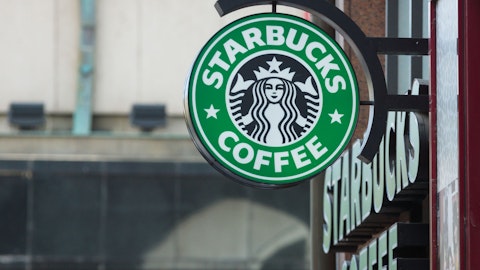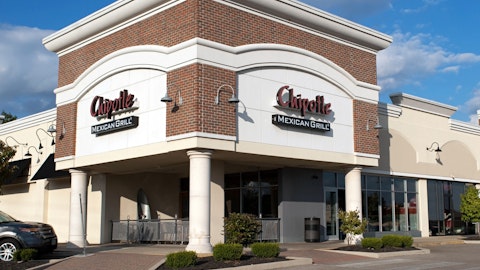Sara Senatore: Okay. And then just quickly on the new store productivity. Could you clarify that sort of there, it’s 1,000 basis points better? Is that because the Chipotlanes open at higher volumes than non-Chipotlanes, and so it’s just sort of comparing the different models? Or is there something else going on where across the board, new store productivity is better? Thank you.
Jack Hartung: Yes. Sara, I’ll take this. I think it’s really more based on the Chipotlanes. Because if you look over the last four years or so, you got to look over a longer period of time to look at all the opening, we’ve moved up our productivity. So for example, today, our restaurants open up on average around 85% of what our existing comp stores are doing. If you look back three years or four years ago, we were in kind of the high 70% range or so. So there’s been a step change. And the biggest thing that’s happened from the three years, three and a half years ago to today is we’ve moved from having just a handful of Chipotlanes to having the majority of our portfolio is Chipotlane. And we still €“ when we look at what our Chipotlanes are doing, the 85% compared to 15% without a Chipotlane, they continue to outperform that non-Chipotlane cohort.
So, we think the main driver is the Chipotlane and the convenience that our customers find with that digital drive-through.
Sara Senatore: Thank you so much.
Operator: The next question will be from David Palmer from Evercore ISI. Please go ahead.
David Palmer: Thanks. I wanted to ask a question about digital orders. I’ve been somewhat surprised by the level of decline there. I think back in the third quarter, we estimated that digital traffic per store decline in the mid-teens. That’s including both delivery and pickup. Maybe you can comment on where you think that was correct, but also how much you think digital traffic per store declined in the fourth quarter. And just relatedly, what are your thoughts about that channel? I know it’s important to you. What’s your outlook for it? And are there things you can do to stabilize that line? Thanks.
Brian Niccol: Go ahead, Jack.
Jack Hartung: Yes. I’ll get started, David. Listen, there’s a couple of things that are driving it. One is, we’re having a surge in return to in-restaurant. And so that part of our business is growing very, very healthily throughout the last year and a half or two years since we’ve been moving away from the pandemic. But secondly, delivery has been declining as well. Delivery transactions in the fourth quarter declined 15%, and that’s I think just again a normal kind of move away from people getting out and about. And I think there’s probably some people who are deciding that while that channel adds a lot of convenience, there is a higher price that comes with that. So those are the two main drivers. And we figured that digital would kind of settle in this high 30% range.
And so we’re at 37% range now. So it’s within the range that we thought we would be in. And early on in the pandemic, we saw our two markets that were the least affected, that’d be the Southeast and the Southwest. When they were starting to normalize, they were normalizing towards that high 30% range. So it feels like about the right range for us.
David Palmer: So is your view that you’re going to start to kind of lap the second quarter, things really step down? Or do you think you’re going to enjoy that comparisons when it comes to digital orders and start to stabilize on that channel, and then perhaps enjoy some of the benefits you’re talking about with throughput on the front make-line? Is that €“ is your belief that you’re going to get a dual benefit there?
Brian Niccol: Yes. That’s right, David. I mean the way we think about it is, we feel like we’ve reset the delivery business to be now where it makes sense economically. And as such, our order-ahead business, I think, has started to show the right trajectory. And then obviously, our in-store business has shown tremendous acceleration. So, I think you said it well.
David Palmer: Thank you.
Operator: The next question is from Andrew Charles from Cowen. Please go ahead.
Andrew Charles: Great. Thanks. Jack, I have two margin questions for you. There’s obviously a lot of noise in 4Q. Labor cost was 1Q guidance for labor. And I’m curious what the impact of higher expected sick claims have in 4Q. And then I missed the term, but there’s some external factors that you’re betting within the mid-25% labor margins. Can you just help tease us out in terms of what that impact is from that external factor? And then my real question is that if we zoom out and fast forward to when you get the $3 million sales volumes, what’s your level of confidence in achieving 27% restaurant-level margins relative to what you might have said a quarter ago if the sales structure has obviously been up and to the right and you’re rapidly getting towards that target?
Jack Hartung: Yes. So let me start with the fourth quarter. Our expectations were that our margin would be more in the 25% range rather than the 24% range. And when you look at the pieces of how we got down to 24%, part of it was the loyalty breakage. Frankly, there was an 80 basis point change year-over-year in the comp related to just that journal entry that we had to book for the breakage. If you look at just the €“ there was 30 basis points of additional or reduced breakage that we had to reflect this year, that cost us 20 basis points on the margin. It was 60 basis points on €“ we saw higher-than-expected medical claims and sick pay during the quarter as well. We typically do see those things pick up a little bit in the fourth quarter and especially in December.
But it €“ the surge was more than we expected. That’s not something that we would expect to recur. And then sales softened during December as well. I think that went hand-in-hand with softer retail sales. We know there was some weather and a seasonal shift in the holidays and things like that. And that was 20 basis points, 30 basis points or so. So, we look at that margin in the fourth quarter. And we think if those things normalize, there is as much as 100 basis points or so that we can get back. We don’t get it back all at one time, but we definitely think we have the potential to do that. So with that in mind, if you’re looking at more of that high 24% and that 25% range on a normalized basis, then we are confident that as we move from the current volumes on a menu price-adjusted basis just over 20 €“ $2.7 million up towards that $3 million, the flow-through that we know our model provides will still get us to that 27%.
Andrew Charles: And can you just clarify €“ I’m sorry, you said sales were a bit softer than you guys expected in December. But I think earlier in the script, you guys talked about how there was improvement through the quarter. So was that just a reflection that December didn’t perform to the level that you guys were really expecting?
Jack Hartung: Yes. I mean, listen, the way I would describe the quarter, we started out soft and we talked about that in October that we were doing a mid-single-digit comp, that GGS, while there was an attachment rate that was as expected, it wasn’t driving transactions. So, we started out soft in the quarter. We picked up as we stopped comparing against brisket. That was in the middle of November. So we had, call it, high single-digit comps for a while. And then we lapped the menu pricing increase from December of 2021. And then just as we got around the holiday, we just didn’t see that pop, that momentum that we normally see in €“ so December. So the way I would describe it is, frankly, we started the quarter soft and we ended the quarter soft.
Now what we’re happy about is, as the holidays €“ we got through the holidays and we got into January, that’s where our transaction, not just from a comparison standpoint but just on a trend month-over-month, really did improve. And so we feel good about where we go from here. But yes, listen, the fourth quarter was a tough quarter for us.





